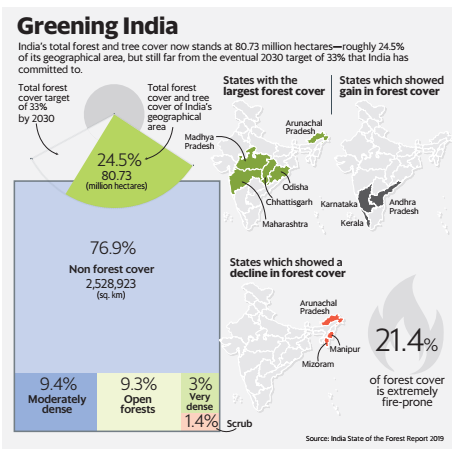Contents
- Return of Bonds
- Same country, different script
- India Added to its Green Cover, But the Numbers are Questionable
- India’s economic slowdown: Slow and Slower
RETURN OF BONDS
Why in news?
Supreme court refused to hear the plea to order stay on the functioning of electoral bonds, which are said to be advantageous only to ruling party.
In April 2019, CJI had asked political parties to disclose to the Election
Commission of India (ECI), in sealed covers, details of the donations they had received through the anonymous bonds.
Why concerns?
- The Association for Democratic Reforms, the petitioner, has disclosed that an
- Overwhelming majority of the donations made through electoral bonds had gone to the Bhartiya Janata Party.
- ECI, in its response filed in the court said that provisions would enable the creation of shell companies for the sole purpose of making political donations
- Amendments to the law on foreign contributions would mean that there would be unchecked foreign funding of political parties, leading to foreign influence on India’s policymaking
SAME COUNTRY, DIFFERENT SCRIPT
Change in Pakistan’s attitude
Both Islamabad and Rawalpindi, Pakistan’s two centres of power, are now on the same page in seeking “honorable peace” with New Delhi on the basis of “sovereign equality”
There is now broad recognition in most sections of Pakistani society and polity that their country has paid a very heavy price by supporting the forces of Islamist extremism and terrorism, and by using these for achieving mistaken foreign policy ends in Afghanistan and India.
Many factors have influenced the welcome winds of change in Pakistan.
- There is across-the-board realization that Pakistan has suffered a lot, both domestically and in terms of damage to its global image, by supporting religious extremism and terrorism.
- Terrorists have killed a shockingly large number of civilians certainly far many more than in India.
- Several thousand soldiers have lost their lives in the army’s “war on terror” — more than the number of casualties in all the wars with India.
- Furthermore, Islamabad is under relentless pressure from the Financial Action Task Force (FATF) to act decisively and irreversibly against terrorist Organisations
- China, which has emerged as Pakistan’s most important economic and security partner- The China-Pakistan Economic Corridor (CPEC), a flagship project under Beijing’s Belt and Road Initiative (BRI), has begun to modernize the country’s infrastructure spectacularly.
- Opening of the Kartarpur Sahib Corridor, perhaps the greatest confidence-building measure between the two countries since 1947, is almost entirely due to Gen. Bajwa’s personal commitment to the project.
INDIA ADDED TO ITS GREEN COVER, BUT THE NUMBERS ARE QUESTIONABLE
Why in news?
The latest State of Forest Report seems to have tip-toed around several pertinent issues, including how ‘forest cover’ is defined, say ecologists
Details/Analysis
- ISFR,2019 shows India among the few countries in the world showing a consistent rise in its forest cover—a trend
- which aligns well with its ambitious climate action targets
- The assessment carried out biennially shows India’s forest cover has increased by 3,976 sq. km since 2017—a rise of 0. 56%.
- Tree cover—tree patches of size less than one hectares outside the recorded forest areas, also showed a rise, albeit a little higher at 1.29%
- India’s total forest and tree cover now stands at 80.73 million hectares—roughly 24.5% of its geographical area, and still far from the eventual target of 33%, which India has committed to raise to, by 2030
What are the concerns?
- Forest Survey of India defines forest cover as “all patches of land, with a tree canopy density of more than 10% and more than one hectare in area, irrespective of land-use, ownership and species of trees”—an assessment relying majorly on satellite mapping.
- “If we stick to definition, then any fruit garden, coconut or coffee plantation, or even urban parks would come under ‘forest cover’. So, what we get is an incomplete picture of our forests.
- Satellite Mapping is unable to look into the quality of these forests or its biodiversity
- Report misses the point that several thousand hectares of land is being diverted for non-forest use, taking away lakhs of tree
- Compensatory plantation done to replace the original, natural forests during diversion of forest-lands for projects have so far yielded no impactful results

Way ahead
- Instead of just canopy cover or hectares, the need is to focus on what is a ‘thriving forest’ or an ‘ecosystem’
- We need real time spatial data of our forest land
- Changing climatic conditions have thrown newer challenges. Forests are sink and reservoirs of carbon, thus critical in adaptation to climate change
- Any afforestation activity undertaken must include an adaptation programme because it is futile planting new trees, which will be adversely impacted due to climate change
INDIA’S ECONOMIC SLOWDOWN: SLOW AND SLOWER
Why in news?
In its latest World Economic Outlook, the International Monetary Fund (IMF) has presented a sobering assessment of the state of the Indian economy
Details
- IMF notes that the downward revision in India’s growth prospects is more due to domestic issues — domestic demand has slowed down more sharply than expected amid stress in the non-banking financial sector, a decline in credit growth and poor growth in rural incomes.
- There is a need to address domestic issues at fast pace
- Credit growth- lot of liquidity with the banks, liquidity crunch with the industry
- Large NPA – a time bomb ticking to explode
- Agricultural sector slowdown
- Large food stock with FCI
- Lower GST and IT collections
- Low private investments
- Government’s fiscal prudence is at risk which may invite futher rating downgrade from agencies




